| Dactylosaurus Temporal range: Early-Middle Triassic, | |
|---|---|
| Scientific classification | |
| Domain: | Eukaryota |
| Kingdom: | Animalia |
| Phylum: | Chordata |
| Class: | Reptilia |
| Superorder: | †Sauropterygia |
| Family: | †Pachypleurosauridae |
| Genus: | †Dactylosaurus Gürich, 1884 |
| Type species | |
| †Dactylosaurus gracilis Gürich, 1884 | |
| Synonyms | |
| |
Dactylosaurus is a genus of nothosaur in the family Pachypleurosauridae. Along with Anarosaurus, Dactylosaurus was one of the earliest known pachypleurosaurs to come from Europe.[1]
Etymology
Dactylosaurus comes from the Greek daktulos (δακτυλος), "finger" and sauros (σαυρος), meaning "lizard" or "reptile."
Description
Dactylosaurus was a small reptile measuring up to 50 cm (1.6 ft) long.[2] The nasal bones of Dactylosaurus meet and are broadly structured.[3] The upper temporal fenestra is large and kidney-shaped.[3] There are 17 cervical vertebrae[3] and the cervical ribs have anterior processes.[3] The maxillae of Dactylosaurus extended broadly up the side of the snout.[1]
D. gracilis
The holotype specimen (MGUWR WR 3871s) of D. gracilis was only a partial skeleton, consisting of the anterior end alone.[1] Because it differed slightly from the fossils of D. gracilis, it was first thought to belong to the species D. schroederi,[1] which is now considered a junior synonym for juvenile D. gracilis.[3] Once this was established, the juvenile fossil, which was found before the adult fossils, became the holotype. The one limb that was found (a left forelimb), was noted to have a slimmer radius and ulna than Neusticosaurus,[1] a similar nothosaur from Europe.[1] D. gracilis is the smallest known species in its family,[1] which includes the much more recognized Keichousaurus, a nothosaur often remembered for its small size.[4] The original holotype of D. gracilis is considered a juvenile,[3] however the size of a nothosaur when its bones harden is used to show size, making the estimate as smallest member of its family still valid.[1]
Distribution
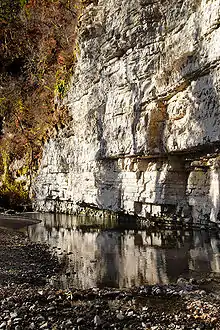
Dactylosaurus lived in the Early and Middle Triassic period during the Late Olenekian and Anisian[3] faunal stage, of central Europe.[5]
In terms of geology, they are found: 1) in the uppermost Röt (uppermost Buntsandstein; Lower Triassic): e.g. Michałkowice (Siemianowice Śląskie) and Kamień Śląski, S Poland,[3] (the second location is not sure because Röt is not exposed there), 2) in the lowermost Muschelkalk (Middle Triassic), inter alia in the Gogolin Formation - Gogolin and its vicinity, S Poland.[5][6]
In 2012, the new Röt site (~ 247 Ma; Lower Triassic; the latest Olenekian) with abundant disarticulated remains of Dactylosaurus was found in Gogolin. Presently, this in the only site where Dactylosaurus remains are accessible to collect.[7][8][9]
References
- 1 2 3 4 5 6 7 8 Lepidosauromorpha: Pachypleurosauridae: Dactylosaurus & Anarosaurus Archived 2008-06-24 at the Wayback Machine Palaeos.com. Last accessed 2008-07-04.
- ↑ Klein, N.; Griebeler, E.M. (2018). "Growth patterns, sexual dimorphism, and maturation modeled in Pachypleurosauria from Middle Triassic of central Europe (Diapsida: Sauropterygia)". Fossil Record. 21 (1): 137–157. doi:10.5194/fr-21-137-2018.
- 1 2 3 4 5 6 7 8 Rieppel, O & L Kebang (1995), "Pachypleurosaurs (Reptilia, Sauropterygia) from the Lower Muschelkalk, and a review of the Pachypleurosauroidea." Fieldiana Geol. N.S. 32: 1-44.
- ↑ "peripatus.gen.nz entry on Keichousaurus". Archived from the original on 2008-04-29. Retrieved 2008-06-12.
- 1 2 "plesiosauria.com entry on Dactylosaurus". Archived from the original on 2009-01-05. Retrieved 2008-06-13.
- ↑ Sues H-D., Carroll R.L. 1985. The pachypleurosaurid Dactylosaurus schroederi (Diapsida: Sauropterygia). Canadian Journal of Earth Sciences 22(11): 1602-1608
- ↑ Kowal-Linka M., Bodzioch A. 2012a. Warstwy kościonośne z Dactylosaurus (Reptilia, Sauropterygia) z retu (trias dolny, olenek) Opolszczyzny Bonebeds with Dactylosaurus (Reptilia, Sauropterygia) from the Röt (Lower Triassic, Olenekian) in the Opole Silesia region (S Poland). Przegląd Geologiczny 60 (12): 646–649
- ↑ Kowal-Linka M., Bodzioch A. 2012b. New findings of vertebrate remains from the Röt (Lower Triassic, Olenekian) in the vicinity of Gogolin (Opole Silesia, S Poland). [W:] Krasiejów - inspiracje paleontologiczne / Krasiejów - paleontological inspirations. E. Jagt-Yazykova, J. Jagt, A. Bodzioch, D. Konietzko-Meier (red.). Zakład Poligraficzno-Wydawniczy "Plik", Bytom: 70-80. ISBN 978-83-916841-8-4
- ↑ Kowal-Linka M., Bodzioch A. 2017. Genesis of the Lower Triassic bonebeds from Gogolin (S Poland): The impact of microbial mats on trapping of vertebrate remains. Palaeogeography, Palaeoclimatology, Palaeoecology 466, 38–58
External links
- Pachypleurosauridae from Palaeos.com (technical)
- Dactylosaurus from the Plesiosaur Directory
- http://www.nrcresearchpress.com/doi/abs/10.1139/e85-169
- Kowal-Linka & Bodzioch 2012a
- Kowal-Linka & Bodzioch 2012b
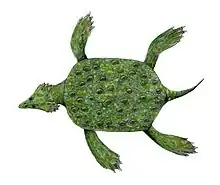
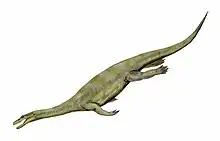
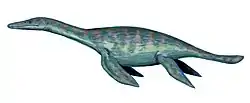

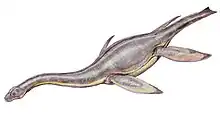
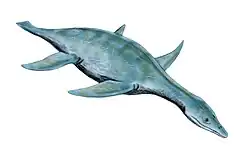
.png.webp)